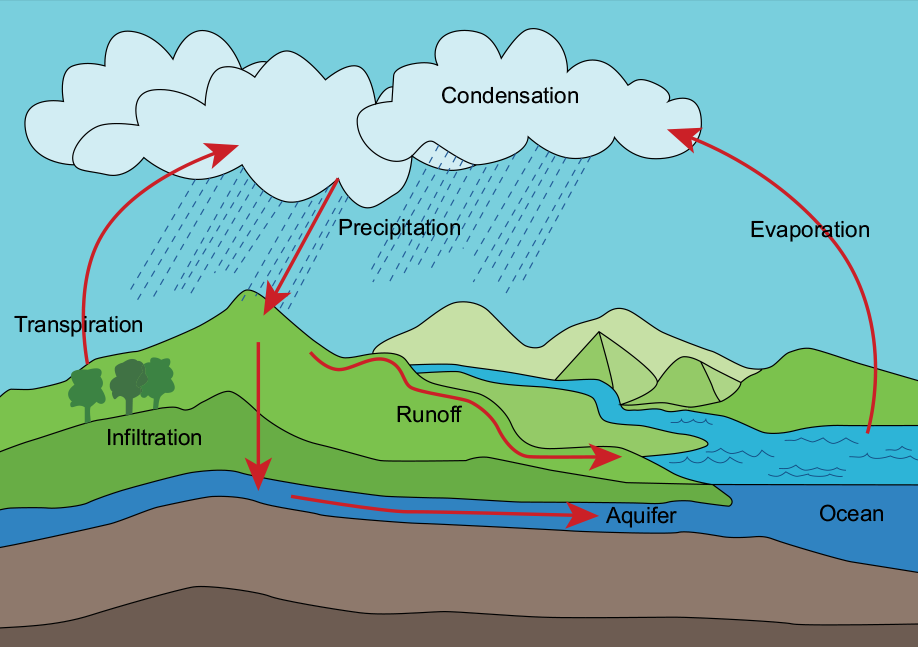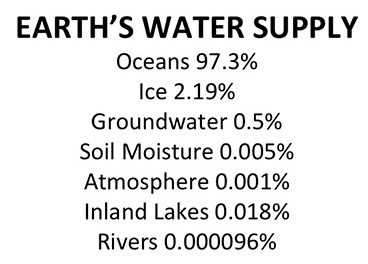Lesson Plan
Water Supply
Grade Level
Purpose
Students observe the change of water states as it moves through the water cycle. Grades 3-5
Estimated Time
Materials Needed
Engage:
- Water
- Large, clear plastic bowl
- Masking Tape
- Clear glass
- Ice
- Water in Agriculture pictures
Activity 1: Water Cycle
- Water Cycle in a Cup:
- Water Cycle Diagram
- Plastic cup, 1 per pair of students
- Plastic wrap
- Water
- Tape
- Crayons or permanent marker
- Landform Cutout, 1 per pair of students
- Water Cycle Demonstration:
- Large, clear plastic bowl
- Small container (like a butter tub)
- Water
- Clear plastic wrap
- Large rubber band
- Small weight (like a rock with a diameter the size of a quarter)
Activity 2: The Earth's Water Supply
- Water
- 1-gallon container (such as a plastic ice cream bucket)
- 1/2-cup measuring cup
- Clear bowl
- Eye dropper
- Small plate
Vocabulary
condensation: water that collects as droplets on a cold surface when humid air is in contact with it
evaporation: the changing of a liquid into a gas
gas: a state of matter where a substance (such as oxygen or hydrogen) is like air and has no fixed shape
infiltration: to pass through a substance by filtering or permeating
irrigation: artificial application of water to the land or soil to assist plant growth
liquid: a state of matter in which a substance exhibits ability to flow freely like water; not a solid or a gas
precipitation: moisture in the form of rain, snow, sleet, or hail that falls to the ground
solid: a state of matter where a substance has a definite shape and volume; not liquid or gaseous
water: a transparent, odorless, tasteless liquid, a compound of hydrogen and oxygen
Background Agricultural Connections
One of the most important natural resources that covers the earth’s surface is water. All living things depend on water for survival. As the world population continues to grow, more and more people, plants, animals, and other living creatures need water to live. Water is a renewable resource used over and over through evaporation, transpiration, and precipitation. The water that is on earth now is the same water that has always been here. No “new” water is being made.
The movement of water in and around the earth is called the water cycle. The water cycle is continuous. Rain or snow falls on oceans and land as precipitation. The soil will soak up some of the water. Plants will take up some of this water through their roots, and some water will move down through the soil to become groundwater. Some of the water from the rain and snow will run off the land into streams, marshes, lakes, and oceans. The water that remains on the earth’s surface is called surface water. The surface water will return to the atmosphere through evaporation. Then water vapor may form clouds that cause precipitation—rain or snow—to occur again. The precipitation will return to the surface of the earth, and the cycle will continue. Through different stages of the water cycle, water can be liquid, solid, or gas.
Water is extremely important for crop production because crops (plants) need water to grow. A good crop of corn or soybeans needs at least 20 inches of water a year. Yet, almost every year, the corn and soybeans’ water is limited to some degree by drought. Drought occurs when there is a lack of water. Some years the summer rainfall is below normal, and some years there are varying amounts of rainfall throughout the season. For this reason, more and more farmers are installing irrigation systems to ensure that their crops receive an adequate amount of water. Irrigation means watering land with artificial methods, or man-made watering. Water is taken from lakes, rivers, streams, and wells, transported to croplands, and used to water the crops. Irrigation is used in areas that go without rainfall for a long time. Places such as the southwestern United States, Egypt, and Italy use irrigation during dry periods or all year.
Engage
- Place one cup of water into a clear bowl. Place a piece of masking tape on the outside of the bowl at the top of the water line. Set the bowl on a sunny window sill. Check the bowl every half-hour to see what happens. The sun will warm the water and cause the water to evaporate. This means that the water will turn from a liquid into a gas (water vapor). The amount of water in the bowl will decrease when the liquid turns into water vapor. (Remind students that we cannot see water vapor.)
- After you place the bowl of water on the window sill, fill a clear glass three-fourths full with ice. Set the glass of ice where most students can watch it. Check the glass every 15 to 20 minutes to see what happens. Explain to your students that ice is the solid state of water. Ice will melt because the classroom is not at a cold enough temperature to keep the ice frozen. The melting ice demonstrates the change of a solid to a liquid.
- Clarify for the students that water exists in different forms. Water can exist as a liquid (water), solid (ice), or gas (water vapor) and can change from one to another.
- Show your students the Water in Agriculture pictures attached to this lesson.
- You can print the pictures or project them on a screen
- As you display the pictures, ask students to identify what they see in common in the pictures.
- Students should recognize water in each picture. They should also recognize that each picture shows a plant or animal that is produced to provide our food.
- Begin a basic conversation with your students about the importance of water. Likely, they already know that we need water in our bodies to live and be healthy. Help them extend their knowledge and begin to understand that without water, farmers could not provide our food.
Explore and Explain
Activity 1: Water Cycle
Explain to the students that water changes from one form into another naturally in the environment. Choose one of the two water cycle activities to help students understand how water changes from one form into another in nature.
- Water Cycle in a Cup:
 Organize students into groups of two and explain the directions for the Water Cycle in a Cup activity. Review key vocabulary that are labeled on the Water Cycle Diagram and make sure students understand their meaning.
Organize students into groups of two and explain the directions for the Water Cycle in a Cup activity. Review key vocabulary that are labeled on the Water Cycle Diagram and make sure students understand their meaning.- Color the Landform Cutout.
- Tape the landform drawing to the back of the cup.
- Add 60 ml (1/4 cup) of water to the earth cup and cover with plastic to keep the water from evaporating.
- Use a crayon or permanent marker to mark the starting water level with the current time.
- Place the cup outside in the sun for 1/2 hour.
- Observe and discuss changes.
- Water Cycle Demonstration:
- Take the clear, large plastic bowl and place the smaller container (butter tub) in the middle of the large bowl. Pour water into the large bowl, around the small container, but not inside the small container. Fill the large bowl until the water level reaches to about three-fourths of the height of the small container.
- Place a piece of clear plastic wrap over the large bowl. Put the rubber band around the top of the bowl to keep the plastic wrap in place. Take the weight (rock) and put it in the middle of the plastic wrap. Place the “water cycle” inside the classroom in a sunny spot (like a windowsill).
- The sun will heat the water in the large bowl so the water will evaporate, just like the water did in Activity 1. Here the liquid form of water has changed into gas. The evaporated water (gas) will rise and condense on the plastic wrap. This means that the water vapor has turned back into liquid. The water droplets will slide down the plastic wrap until they are underneath the weight (rock). Then they will fall into the small container. The small container collects the water that has been “recycled.”
Activity 2: The Earth’s Water Supply
- Discuss the Earth’s water supply using the information from the introduction.
- Display the following information on a poster or the chalkboard.

- To demonstrate how much of the Earth’s water supply is actually used, ask some students to help you with the next steps. (Make sure that the students understand this is just a demonstration and there is actually more water than this on earth.)
- Pour water into a one-gallon container, such as a plastic ice cream bucket. This represents all the water on the earth.
- Pour a half-cup of water out of the one-gallon container and into a clear bowl. The water in the bowl represents all of the fresh water on earth, which is less than three percent of the total water on earth. Fresh water is found in lakes, rivers, groundwater, ice, and living things. The 15 half-cups that are still in the one-gallon container represent salt water. We cannot use salt water without first removing the salt in a process known as desalination. Though research and technology are improving this process, it is still prohibitively expensive and often impractical.
- With an eyedropper, drop one drop of water from the half-cup onto a small plate. This one drop represents the freshwater that is available for our use. This water is found in rivers and lakes. The rest of the water in the half-cup is deep groundwater, water bound up as soil moisture, biomass water, or water in the atmosphere.
Elaborate
-
Invite a soil and water conservationist into the classroom to talk to the students.
-
Look on a world map to locate where water exists as a solid, a liquid, in the land, oceans, rivers, and lakes.
-
Have the students make posters to teach other students why we should not pollute water. Hang the posters around the school.
-
Learn more about how water is important to us as human beings and to all other living organisms.
-
Play the My American Farm interactive game Wild Water Adventures.
-
Have the students explore what goes into their water or where their water comes from (this is a good place to make connections to the water cycle and/or nitrogen cycle).
-
Have the students design a buffer strip, or other sustainable farming practices, that will also increase biodiversity.
Acknowledgements
- Activity 1 was adapted from California Department of Water Resources.
- Activity 2 of this lesson is found on many websites, and the original author or source is unknown.
Recommended Companion Resources
- Kids' Lab Activity Book
- My American Farm
- Project WET
- Science in Your Watershed
- The Great Big Water Cycle Adventure
- The Story of Bottled Water Video
- The USGS Water Science School
- The Water Lady: How Darlene Arviso Helps a Thirsty Navajo Nation
- Water Pollution Demonstration
- Water is Water
- Water: Sources, Use, Conservation
- Weather Harvest Game
Author
Organization
| We welcome your feedback! If you have a question about this lesson or would like to report a broken link, please send us an email. If you have used this lesson and are willing to share your experience, we will provide you with a coupon code for 10% off your next purchase at AgClassroomStore. |